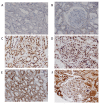Urine levels of HMGB1 in Systemic Lupus Erythematosus patients with and without renal manifestations
- PMID: 22892043
- PMCID: PMC3580580
- DOI: 10.1186/ar4015
Urine levels of HMGB1 in Systemic Lupus Erythematosus patients with and without renal manifestations
Abstract
Introduction: Lupus nephritis (LN) is a severe and frequent manifestation of systemic lupus erythematosus (SLE). Its pathogenesis has not been fully elucidated but immune complexes are considered to contribute to the inflammatory pathology in LN. High Mobility Group Box 1 (HMGB1) is a nuclear non-histone protein which is secreted from different types of cells during activation and/or cell death and may act as a pro-inflammatory mediator, alone or as part of DNA-containing immune complexes in SLE. Urinary excretion of HMGB1 might reflect renal inflammatory injury. To assess whether urinary HMGB1 reflects renal inflammation we determined serum levels of HMGB1 simultaneously with its urinary levels in SLE patients with and without LN in comparison to healthy controls (HC). We also analyzed urinary HMGB1 levels in relation with clinical and serological disease activity.
Methods: The study population consisted of 69 SLE patients and 17 HC. Twenty-one patients had biopsy proven active LN, 15 patients had a history of LN without current activity, and 33 patients had non-renal SLE. Serum and urine levels of HMGB1 were both measured by western blotting. Clinical and serological parameters were assessed according to routine procedures. In 17 patients with active LN a parallel analysis was performed on the expression of HMGB1 in renal biopsies.
Results: Serum and urinary levels of HMGB1 were significantly increased in patients with active LN compared to patients without active LN and HC. Similarly, renal tissue of active LN patients showed strong expression of HMGB1 at cytoplasmic and extracellular sites suggesting active release of HMGB1. Serum and urinary levels in patients without active LN were also significantly higher compared to HC. Urinary HMGB1 levels correlated with SLEDAI, and showed a negative correlation with complement C3 and C4.
Conclusion: Levels of HMGB1 in urine of SLE patients, in particular in those with active LN, are increased and correlate with SLEDAI scores. Renal tissue of LN patients shows increased release of nuclear HMGB1 compared to control renal tissue. HMGB1, although at lower levels, is, however, also present in the urine of patients without active LN. These data suggest that urinary HMGB1 might reflect both local renal inflammation as well as systemic inflammation.
Figures





Comment in
-
Lupus nephritis - alarmins may sound the alarm?Arthritis Res Ther. 2012 Dec 31;14(6):129. doi: 10.1186/ar4109. Arthritis Res Ther. 2012. PMID: 23270666 Free PMC article.
References
-
- Manson JJ, Ma A, Rogers P, Mason LJ, Berden JH, van der Vlag J, D'Cruz DP, Isenberg DA, Rahman A. Relationship between anti-dsDNA, anti-nucleosome and anti-alpha-actinin antibodies and markers of renal disease in patients with lupus nephritis: a prospective longitudinal study. Arthritis Res Ther. 2009;11:R154. doi: 10.1186/ar2831. - DOI - PMC - PubMed
Publication types
MeSH terms
Substances
LinkOut - more resources
Full Text Sources
Medical
Miscellaneous

